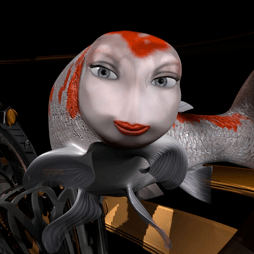
Matthew Weinstein brings old & new; aural & visual; and digital technology to the Charlotte Symphony
By Eva Lewis, Charlotte Symphony
In a groundbreaking endeavor that combines old and new, aural and visual and blends digital technology with centuries of respected tradition, the Charlotte Symphony has commissioned a piece of digital artwork that will premier at a May 4 performance. Created by visual artist Matthew Weinstein, the piece is a 16-minute original animated video to be displayed on a screen suspended above the orchestra. The audience will experience brilliant animation in sync with the hypnotic music of Ravel’s Bolero.
Resulting from a partnership between the Knight Foundation and the Charlotte Symphony, the project encompasses the Knight Foundation, Charlotte Symphony and Mint Museum of Charlotte as they join in the premiere with an exhibition of Weinstein’s work. For examples of Weinstein’s work, click here.
In addition to being a landmark event for the arts community of Charlotte, North Carolina, this project symbolizes the current shifting landscape of the performing arts, especially those grounded in classical tradition.
“Today’s audiences have high expectations and increasingly want to become more deeply engaged in artistic performances,” said Dennis Scholl, vice president for arts at Knight Foundation. “With this performance, and the entire KnightSounds series, we hope to spark new interest in our leading cultural organizations, and remind people of the power of the arts in their lives.”
This project is a refreshing juxtaposition of art forms that are radically different at first glance, but Bolero and digital animation share more than you might think. “I approached the abstract narrative with Fantasia in mind,” said Weinstein. “Fantasia told a compelling story through classical music and animation, meanwhile introducing the music to those who wouldn’t otherwise have experienced it. Pop culture can be used in a way so that it doesn’t degrade something old but instead enhances it.”
This departure from the format considered as traditional is not necessarily drastic, but a disassembling of the imposed constructs of the last 150 years. It also prompts discussion of modern-day concert boundaries: what defines a concert? How interactive should the experience be? How can organizations implement new works while honoring the masters? How can artists and organizations combine different art forms into a synchronized experience?
As orchestras continue to redefine the parameters of their work in the digital age, these are questions that will serve to create the ensembles of the future. Thanks to audience engagement, many organizations are already well on their way to creating engaging performances with a broad reach. Collaboration, innovation and expanding parameters are key to the future growth of the arts.
Recent Content
-
Artsarticle ·
-
Artsarticle ·
-
Artsarticle ·
